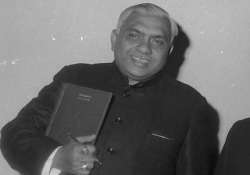Court rules out medical negligence in L N Mishra's death
New Delhi: Lalit Narayan Mishra had died due to the injuries sustained in the blast and not due to delay in treatment, a Delhi court has said while rejecting contentions of the convicts who had

New Delhi: Lalit Narayan Mishra had died due to the injuries sustained in the blast and not due to delay in treatment, a Delhi court has said while rejecting contentions of the convicts who had sought benefit of doubt arguing that the then Railway minister had died due to medical negligence.
In his 1090-page verdict convicting four persons in the 1975 murder case, district judge Vinod Goel trashed the submissions of defence counsel during the trial that Mishra had died due to cardiac arrest while undergoing surgery and it was the negligence of the doctors treating him.
The court said after the blast incident, Mishra was rushed to Danapur for treatment and several doctors treated him. “Even if there was some delay in providing medical treatment to L N Mishra (in this case there being no such intentional delay caused by the medical experts), the accused persons cannot escape the rigour of law and claim benefit of doubt,” the court said.
“This court does not find any clue to comment on the death of L N Mishra due to medical negligence,” it said, adding, the “death was due to injuries on vital parts of his body by the splinters of bomb.”
On the contentions of defence counsel that precious time was lost during transit of Mishra from Samastipur to Danapur which worsened his condition, the court said that treatment at Samastipur and Darbhanga was not preferred due to lack of proper medical facilities in hospitals there. During the trial, the defence counsel had also raised the point that postmortem was not conducted on Mishra's body to hide the actual reason of his death.
The court, in its verdict, rejected the contentions of the defence lawyers saying, “Apparently the death was due to the injuries on vital parts of his body by the splinters of bomb, there was no necessity of his postmortem.”